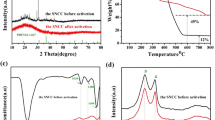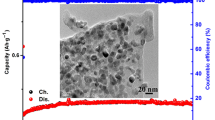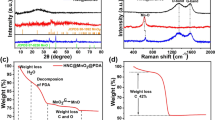Abstract
Cobalt/iron oxide nanoparticles (CFO/NPs) were fabricated with a facile solid combustion method and decorated on polyaniline-derived porous N-doped carbon nanosheets. The N-doped carbon nanosheets provide a pathway for charge transfer and act as defensive layers to avoid the agglomeration of nanoparticles. The decoration of CFO nanoparticles on porous N-doped carbon nanosheets (CFO/NC) typically leads to hybrid material that displays an exceptionally high electrochemical performance for Li-ion batteries (LIBs) with excellent diffusion of electrolyte ions and ensures fast Li+/e− transport. The initial discharge capacity reaches up to 1270 mAh g−1 (1.65 mAh cm−2) at a current density of 500 mA g−1 (0.65 mA cm− 2). Furthermore, it also exhibits an exceptionally high specific capacity of 635 mAh g−1 at a high current density of 500 mA g−1 (500 mA g−1) after long cycling (250 cycles) and a remarkable rate capability with 93% capacity retention. These excellent electrochemical characteristics demonstrate that CFO/NC is a promising anode material for LIBs.
Graphical abstract








Similar content being viewed by others
References
Goodenough JB, Park K-S (2013) The Li-Ion rechargeable battery: a perspective. J Am Chem Soc 135:1167–1176
Panwar NL, Kaushik S, C, Kothari S (2011) Role of renewable energy sources in environmental protection: a review. Renew Sustain Energy Rev 15:1513–1524
Li J, Aslam MK, Chen C (2018) One-pot hydrothermal synthesis of porous α-Ni(OH)2/C composites and its application in Ni/Zn alkaline rechargeable battery. J Electrochem Soc 165:A910–A917
Li S, Cen Y, Xiang Q, Aslam MK, Hu B, Li W, Tang Y, Yu Q, Liu Y, Chen C (2019) Vanadium dioxide–reduced graphene oxide binary host as an efficient polysulfide plague for high-performance lithium–sulfur batteries. J Mater Chem A. https://doi.org/10.1039/C8TA10422K
Zhou Y, Liu Y, Zhao W, Wang H, Li B, Zhou X, Shen H (2015) Controlled synthesis of series NixCo3–xO4 products: morphological evolution towards quasi-single-crystal structure for high-performance and stable lithium-ion batteries. Sci Rep 5:11584
Huang G, Zhang F, Zhang L, Du X, Wang J, Wang L (2014) Hierarchical NiFe2O4/Fe2O3 nanotubes derived from metal organic frameworks for superior lithium ion battery anodes. J Mater Chem A 2:8048–8053
Sun S, Wen Z, Jin J, Cui Y, Lu Y (2013) Synthesis of ordered mesoporous CuCo2O4 with different textures as anode material for lithium ion battery. Microporous Mesoporous Mater 169:242–247
Song X, Ru Q, Zhang B, Hu S, An B (2014) Flake-by-flake ZnCo2O4 as a high capacity anode material for lithium-ion battery. J Alloys Compd 585:518–522
Zheng F, Zhu D, Chen Q (2014) Facile fabrication of porous NixCo3–xO4 nanosheets with enhanced electrochemical performance as anode materials for Li-ion batteries. ACS Appl Mater Interfaces 6:9256–9264
Mohamed SG, Chen C-J, Chen CK, Hu S-F, Liu R-S (2014) High-performance lithium-ion battery and symmetric supercapacitors based on FeCo2O4 nanoflakes electrodes. ACS Appl Mater Interfaces 6:22701–22708
Guo H, Li T, Chen W, Liu L, Yang X, Wang Y, Guo Y (2014) General design of hollow porous CoFe2O4 nanocubes from metal-organic frameworks with extraordinary lithium storage. Nanoscale 6:15168–15174
Yang G, Xu X, Yan W, Yang H, Ding S (2014) Single-spinneret electrospinning fabrication of CoMn2O4 hollow nanofibers with excellent performance in lithium-ion batteries. Electrochim Acta 137:462–469
Zhang J, Liang J, Zhu Y, Wei D, Fan L, Qian Y (2014) Synthesis of Co2SnO4 hollow cubes encapsulated in graphene as high capacity anode materials for lithium-ion batteries. J Mater Chem A 2:2728–2734
Fu X, Chen D, Wang M, Yang Y, Wu Q, Ma J, Zhao X (2014) Synthesis of porous CoFe2O4 octahedral structures and studies on electrochemical Li storage behavior. Electrochim Acta 116:164–169
Aslam MK, Shah SSA, Li S, Chen C (2018) Kinetically controlled synthesis of MOF nanostructures: single-holed hollow core–shell ZnCoS@Co9S8/NC for ultra-high performance lithium-ion batteries. J Mater Chem A 6:14083–14090
Yang X, Wang X, Zhang Z (2005) Electrochemical properties of submicron cobalt ferrite spinel through a co-precipitation method. J Cryst Growth 277:467–470
Lavela P, Tirado JL (2007) CoFe2O4 and NiFe2O4 synthesized by sol–gel procedures for their use as anode materials for Li ion batteries. J Power Sources 172:379–387
Ding Y, Yang Y, Shao H (2012) Synthesis and characterization of nanostructured CuFe2O4 anode material for lithium ion battery. Solid State Ionics 217:27–33
Torad NL, Salunkhe RR, Li Y, Hamoudi H, Imura M, Sakka Y, Hu C-C, Yamauchi Y (2014) Electric double-layer capacitors based on highly graphitized nanoporous carbons derived from ZIF-67. Chem Eur J 20:7895–7900
Liu Y, Jiang H, Zhu Y, Yang X, Li C (2016) Transition metals (Fe, Co, and Ni) encapsulated in nitrogen-doped carbon nanotubes as bi-functional catalysts for oxygen electrode reactions. J Mater Chem A 4:1694–1701
Liu B, Shioyama H, Akita T, Xu Q (2008) Metal-organic framework as a template for porous carbon synthesis. J Am Chem Soc 130:5390–5391
Sun J-K, Xu Q (2014) Functional materials derived from open framework templates/precursors: synthesis and applications. Energy Environ Sci 7:2071–2100
Bhattacharyya S, Konkena B, Jayaramulu K, Schuhmann W, Maji TK (2017) Synthesis of nano-porous carbon and nitrogen doped carbon dots from an anionic MOF: a trace cobalt metal residue in carbon dots promotes electrocatalytic ORR activity. J Mater Chem A 5:13573–13580
Liu J, Xiao J, Zeng X, Dong P, Zhao J, Zhang Y, Li X (2017) Combustion synthesized macroporous structure MFe2O4 (M = Zn, Co) as anode materials with excellent electrochemical performance for lithium ion batteries. J Alloys Compd 699:401–407
Sharifi I, Shokrollahi H, Doroodmand MM, Safi R (2012) Magnetic and structural studies on CoFe2O4 nanoparticles synthesized by co-precipitation, normal micelles and reverse micelles methods. J Magn Magn Mater 324:1854–1861
Marco JF, Gancedo JR, Gracia M, Gautier JL, Ríos E, Berry FJ (2000) Characterization of the nickel cobaltite, NiCo2O4, prepared by several methods: an XRD, XANES, EXAFS, and XPS study. J Solid State Chem 153:74–81
Xia W, Mahmood A, Zou R, Xu Q (2015) Metal-organic frameworks and their derived nanostructures for electrochemical energy storage and conversion. Energy Environ Sci 8:1837–1866
Tang C, Wang H-F, Chen X, Li B-Q, Hou T-Z, Zhang B, Zhang Q, Titirici M-M, Wei F (2016) Topological defects in metal-free nanocarbon for oxygen electrocatalysis. Adv Mater 28:6845–6851
Liu Y, Shen Y, Sun L, Li J, Liu C, Ren W, Li F, Gao L, Chen J, Liu F, Sun Y, Tang N, Cheng H-M, Du Y (2016) Elemental superdoping of graphene and carbon nanotubes. Nat Commun 7:10921
Amiinu IS, Liu X, Pu Z, Li W, Li Q, Zhang J, Tang H, Zhang H, Mu S (2018) From 3D ZIF nanocrystals to Co–Nx/C nanorod array electrocatalysts for ORR, OER, and Zn–Air batteries. Adv Funct Mater 28:1704638
Rai AK, Gim J, Thi TV, Ahn D, Cho SJ, Kim J (2014) High rate capability and long cycle stability of Co3O4/CoFe2O4 nanocomposite as an anode material for high-performance secondary lithium ion batteries. J Phys Chem C 118:11234–11243
Shi W, Zhu J, Rui X, Cao X, Chen C, Zhang H, Hng HH, Yan Q (2012) Controlled synthesis of carbon-coated cobalt sulfide nanostructures in oil phase with enhanced Li storage performances. ACS Appl Mater Interfaces 4:2999–3006
Wang Y, Wu J, Tang Y, Lü X, Yang C, Qin M, Huang F, Li X, Zhang X (2012) Phase-controlled synthesis of cobalt sulfides for lithium ion batteries. ACS Appl Mater Interfaces 4:4246–4250
Xing Z, Ju Z, Yang J, Xu H, Qian Y (2013) One-step solid state reaction to selectively fabricate cubic and tetragonal CuFe2O4 anode material for high power lithium ion batteries. Electrochim Acta 102:51–57
Mao J, Hou X, Wang X, Hu S, Xiang L (2015) The cubic aggregated CoFe2O4 nanoparticle anode material for lithium ion battery with good performance. Mater Lett 161:652–655
Xie Q, Li F, Guo H, Wang L, Chen Y, Yue G, Peng D-L (2013) Template-free synthesis of amorphous double-shelled zinc–cobalt citrate hollow microspheres and their transformation to crystalline ZnCo2O4 microspheres. ACS Appl Mater Interfaces 5:5508–5517
Xie Q, Zeng D, Ma Y, Lin L, Wang L, Peng D-L (2015) Synthesis of ZnO–ZnCo2O4 hybrid hollow microspheres with excellent lithium storage properties. Electrochim Acta 169:283–290
Duan L, Wang Y, Wang L, Zhang F, Wang L (2015) Mesoporous MFe2O4 (M = Mn, Co, and Ni) for anode materials of lithium-ion batteries: synthesis and electrochemical properties. Mater Res Bull 61:195–200
Wang B, Li S, Wu X, Li B, Liu J, Yu M (2015) Nanocrystal-constructed mesoporous CoFe2O4 nanowire arrays aligned on flexible carbon fabric as integrated anodes with enhanced lithium storage properties. Phys Chem Chem Phys 17:21476–21484
Wang J, Yang G, Wang L, Yan W, Wei W (2017) C@CoFe2O4 fiber-in-tube mesoporous nanostructure: formation mechanism and high electrochemical performance as an anode for lithium-ion batteries. J Alloys Compd 693:110–117
Zhou J, Yang T, Mao M, Ren W, Li Q (2015) Enhanced electrochemical performance of hierarchical CoFe2O4/MnO2/C nanotubes as anode materials for lithium-ion batteries. J Mater Chem A 3:12328–12333
Xiong QQ, Tu JP, Shi SJ, Liu XY, Wang XL, Gu CD (2014) Ascorbic acid-assisted synthesis of cobalt ferrite (CoFe2O4) hierarchical flower-like microspheres with enhanced lithium storage properties. J Power Sources 256:153–159
Acknowledgements
This work is supported by National Natural Science Foundation of China (Grant No. 21273292).
Author information
Authors and Affiliations
Corresponding authors
Additional information
Publisher’s Note
Springer Nature remains neutral with regard to jurisdictional claims in published maps and institutional affiliations.
Rights and permissions
About this article
Cite this article
Aslam, M.K., Shah, S.S.A., Najam, T. et al. Decoration of cobalt/iron oxide nanoparticles on N-doped carbon nanosheets: Electrochemical performances for lithium-ion batteries. J Appl Electrochem 49, 433–442 (2019). https://doi.org/10.1007/s10800-019-01291-5
Received:
Accepted:
Published:
Issue Date:
DOI: https://doi.org/10.1007/s10800-019-01291-5




